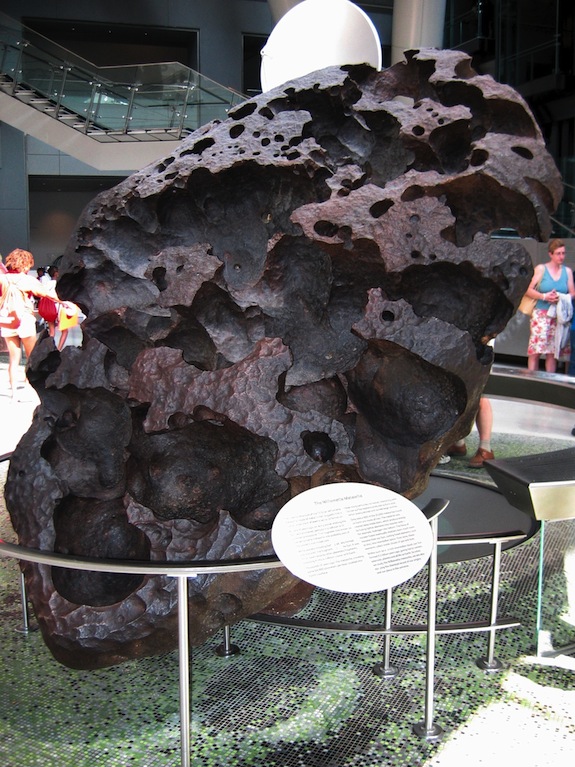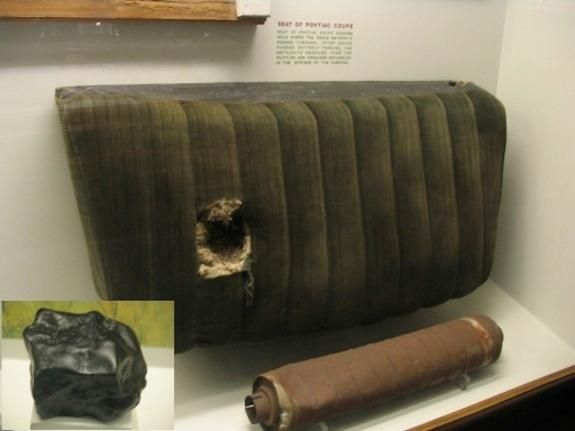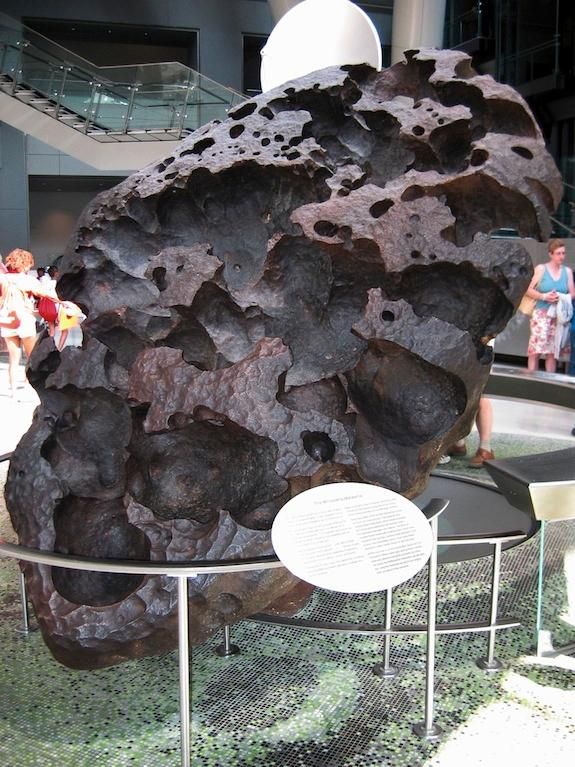A Smithsonian Expert Breaks Down the Science of Meteors
Meteor scientist Cari Corrigan says that the type of destruction wrought by today’s meteor explosion over Russia is exceedingly rare
/https://tf-cmsv2-smithsonianmag-media.s3.amazonaws.com/filer/20130215105033meteor-small.png)
![]()
Today, at around 9:20 a.m. local time in Chelyabinsk, Russia, a massive 11-ton meteor burned up in the sky, triggering a sonic boom that damaged buildings and shattered windows in six cities and reportedly injured hundreds. Eyewitnesses say the meteor’s shockingly bright flash as it burned up (10 seconds into the Russia Today video above) was briefly brighter than the morning sun.
That this event happened today—the same day a 147-foot wide asteroid will whiz extremely close to the Earth at 2:26 p.m. EST—seems to be a coincidence of astronomical proportions, as experts say the two events are entirely unrelated. But unlike the asteroid, which will cause no physical damage, the meteor’s sonic boom as it entered the atmosphere, fractured roughly 18 to 32 miles above the ground and subsequently rained fragments over the region, led to as many as 900 injuries, 31 hospitalizations and widespread damage including the collapse of a rooftop at a zinc factory .
So, what caused this massive explosion? “For one, meteors move extremely fast—faster than the speed of sound—so there’s a ton of friction being generated as it comes through the atmosphere,” says Cari Corrigan, a geologist with the Natural History Museum who specializes in meteors. “If there are any weaknesses in it already, or if there is ice that melts and leaves empty fractures—like freezing and thawing in a pothole—it could easily explode.”
To get a knotty bit of nomenclature out of the way, meteor refers to a variety of pieces of debris—made up of either rock, metal, or a mix of the two—that enter the atmosphere from outer space. Before doing so, they’re called meteoroids. Most burn up entirely during their descent, but if any intact fragments do make it to the ground, they’re called meteorites. Meteors are also called “shooting stars” because of the heat and light produced when they slam into the still atmosphere at supersonic speeds—today’s meteor was estimated to be traveling faster than 33,000 m.p.h.
The distinction between this meteor and the asteroid that will fly past us later today, according to Corrigan, is a matter of size and origin. “Asteroids are generally bigger, and they typically come from the asteroid belt, between Mars and Jupiter,” she says. The size difference also explains why we were able to predict the arrival of the asteroid nearly a year ago, but this meteor caught us by surprise: It’s impossible to spot the smaller meteoroids up in space with our telescopes.
Meteors like the one that fell today aren’t exceedingly rare, but for one to cause this much damage is almost unheard of. “There are events like this in recorded history, but this is likely the first time it’s happened over such a populated area and this level of destruction has been documented,” Corrigan says. Notable meteors in recorded history include the Tunguska event (a 1908 explosion over a remote area in Russia that knocked down more than 80 million trees covering an area of some 830-square miles), the Benld meteorite (a small object that landed in Illinois in 1938 that punctured the roof of a car) and the Carancas impact (a 2007 meteorite that crashed in a Peruvian village and may have caused groundwater contamination).

In 1938, a meteorite fell over Benld, Illinois, puncturing the roof of a car, become embedded in the backseat. Image via Wikimedia Commons/Shsilver
Much larger meteorites have fallen in prehistory and been discovered much later, including the Willamette Meteorite, a 32,000-pound hunk of iron that fell millennia ago and was transported to Oregon during the last ice age. The largest meteorite ever discovered in North America, it is now part of the collections of the Natural History Museum.

The Willamette Meteorite is on view at the Natural History Museum. Image via Wikimedia Commons/Dante Alighieri
Early reports suggest that remnants of the meteor have fallen into a reservoir near the town of Chebarkul; testing on these meteorite fragments could provide more information on the object’s composition and origin. “It might be an ordinary chondrite—which is what 90 percent of the meteorites that we have are made of—or it could be something more rare,” Corrigan says.
While chondrites are made mostly of stone and result from the relatively recent breakup of asteroids, iron meteorites originate from the cores of more ancient asteroids, and even rarer types come from debris broken off from the moon or Mars. ”Every meteorite that we get is another piece of the puzzle,” says Corrigan. “They’re clues towards how the solar system and Earth were formed.”
Today, at around 9:20 a.m. local time in Chelyabinsk, Russia, a massive 11-ton meteor burned up in the sky, triggering a sonic boom that damaged buildings and shattered windows in six cities and reportedly injured hundreds. Eyewitnesses say the meteor’s shockingly bright flash as it burned up (10 seconds into the Russia Today video above) was briefly brighter than the morning sun.
That this event happened today—the same day a 147-foot wide asteroid will whiz extremely close to the Earth at 2:26 p.m. EST—seems to be a coincidence of astronomical proportions, as experts say the two events are entirely unrelated. But unlike the asteroid, which will cause no physical damage, the meteor’s sonic boom as it entered the atmosphere, fractured roughly 18 to 32 miles above the ground and subsequently rained fragments over the region, led to as many as 900 injuries, 31 hospitalizations and widespread damage including the collapse of a rooftop at a zinc factory .
So, what caused this massive explosion? “For one, meteors move extremely fast—faster than the speed of sound—so there’s a ton of friction being generated as it comes through the atmosphere,” says Cari Corrigan, a geologist with the Natural History Museum who specializes in meteors. “If there are any weaknesses in it already, or if there is ice that melts and leaves empty fractures—like freezing and thawing in a pothole—it could easily explode.”
To get a knotty bit of nomenclature out of the way, meteor refers to a variety of pieces of debris—made up of either rock, metal, or a mix of the two—that enter the atmosphere from outer space. Before doing so, they’re called meteoroids. Most burn up entirely during their descent, but if any intact fragments do make it to the ground, they’re called meteorites. Meteors are also called “shooting stars” because of the heat and light produced when they slam into the still atmosphere at supersonic speeds—today’s meteor was estimated to be traveling faster than 33,000 m.p.h.
The distinction between this meteor and the asteroid that will fly past us later today, according to Corrigan, is a matter of size and origin. “Asteroids are generally bigger, and they typically come from the asteroid belt, between Mars and Jupiter,” she says. The size difference also explains why we were able to predict the arrival of the asteroid nearly a year ago, but this meteor caught us by surprise: It’s impossible to spot the smaller meteoroids up in space with our telescopes.
Meteors like the one that fell today aren’t exceedingly rare, but for one to cause this much damage is almost unheard of. “There are events like this in recorded history, but this is likely the first time it’s happened over such a populated area and this level of destruction has been documented,” Corrigan says. Notable meteors in recorded history include the Tunguska event (a 1908 explosion over a remote area in Russia that knocked down more than 80 million trees covering an area of some 830-square miles), the Benld meteorite (a small object that landed in Illinois in 1938 that punctured the roof of a car) and the Carancas impact (a 2007 meteorite that crashed in a Peruvian village and may have caused groundwater contamination).

Much larger meteorites have fallen in prehistory and been discovered much later, including the Willamette Meteorite, a 32,000-pound hunk of iron that fell millennia ago and was transported to Oregon during the last ice age. The largest meteorite ever discovered in North America, it is now part of the collections of the Natural History Museum.

Early reports suggest that remnants of the meteor have fallen into a reservoir near the town of Chebarkul; testing on these meteorite fragments could provide more information on the object’s composition and origin. “It might be an ordinary chondrite—which is what 90 percent of the meteorites that we have are made of—or it could be something more rare,” Corrigan says.
While chondrites are made mostly of stone and result from the relatively recent breakup of asteroids, iron meteorites originate from the cores of more ancient asteroids, and even rarer types come from debris broken off from the moon or Mars. ”Every meteorite that we get is another piece of the puzzle,” says Corrigan. “They’re clues towards how the solar system and Earth were formed.”
/https://tf-cmsv2-smithsonianmag-media.s3.amazonaws.com/accounts/headshot/joseph-stromberg-240.jpg)
/https://tf-cmsv2-smithsonianmag-media.s3.amazonaws.com/accounts/headshot/joseph-stromberg-240.jpg)